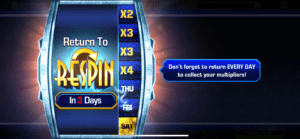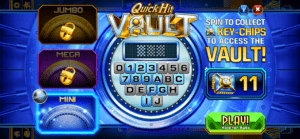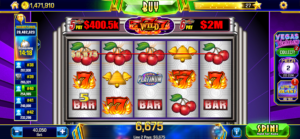For this week’s critical play, I played Quick Hit Slots, a mobile app by Appchi Media and SciPlay. The app’s target audience is adults over 21 years old. This is a traditional game of slots with dozens of different “machines” and in-game currency that players can purchase more of through microtransactions. Quick Hit Slots uses the same strategies as traditional slot machines to keep players addicted and returning for more. Through some minimal user tasks and objectives, the app does everything in its power to have players return to the slot machine to participate in a repeat loop of play driven by luck. Despite its resemblance to gambling, the app does not reward players with any monetary reward, but its mechanics still feed into addiction.
Keep Them Coming Back

Quick Hit Slot’s business model encourages players to return to the app daily at a minimum with multiple game-based incentives, such as loot boxes, daily challenges, and leaderboards. The goal of the app is evidently to bring players back to the slot machines so that they can continue spinning, feeding into addiction in the process. In my first few minutes of playing on the app, the game presented me with daily wheel spins that would increase in value if I played every day (Figure 1) and a leaderboard that refreshed daily (Figure 2).

Each of these respectively invites the player in by promising to fulfill their psychogenic needs for materialism (in the form of coins) and power in the form of leaderboard placement. I was also offered loot boxes that would contain rewards if I returned once they were ready to be opened in a few hours, an introduction with a request to send me push notifications (Figure 3), which would remind me to get back to the slot machines once they were ready.

These mechanics give the player an excuse to return to the app, regardless of the fellowship, sensation, or submission that attracted them in the first place. Each motivator provides a reward in the form of the game’s digital currency, which the player can only use to play on the slot machines. Once the player has started spinning to complete daily challenges (Figure 4) or move up on the leaderboard, they are drawn into the loop of repeat play entirely driven by luck, where anything can happen on the next spin.

In Addiction by Design, the author describes the loop as one that overcomes rational thought and keeps players at the table, spinning just for the thrill of seeing the results. This process is ultimately habit-building as the player learns to check in with the app daily to receive rewards and play the slot machines. The spinning itself becomes intrinsically motivated as the irrational, pleasure-seeking part of the brain settles into hitting the “Spin” button, and they overestimate the odds of winning big.
However, assuming the game’s main goal is to create fun for the player, it could use the outside challenges and rewards as the app’s main appeal rather than simply attractive features to get one to start playing slots. A fourth example of this is the game’s “vaults,” which reveal a reward once the letters and numbers of the combination have been correctly inputted. As the player collects vault chips from playing slots, they can spend them, so the game will randomly select a letter on their behalf, like in the image to the right (Figure 5).

This feature, like the daily wheel spin and the loot boxes, is all driven by luck and no skill, leading the player to feel like they have little autonomy or decision-making abilities. The game could alternatively keep its fully luck-based formula for slots while introducing elements of challenge or puzzles, like having players deduce the vault combination themselves, in its other features to balance the thrill of randomness and the achievement that comes with “winning” off their skill in other parts of the app. This change could, however, interfere with the game’s habit-creating formula, which relies on players giving into the experiential sensations of gambling without much critical input about how the game works on their part, a feeling gamblers enjoy. Compared to other random games, slot machines are especially good at placing players in a position where they are completely beholden to the algorithm behind the screen, a state that leaves players feeling like huge wins are just out of reach. Taking away the player’s autonomy is a purposeful choice by the creators to have users keep returning for more with very little barrier to entry in the form of skill. This ultimately reveals a dark pattern where players arrive to spin their daily wheel, which gives them coins and then shoves dozens of slot machines in their faces to get them to spend them before they leave.
When Fake Money Becomes Real
Quick Hit Slots’s slot machines use multiple psychological and design techniques to make the player feel like the likelihood of winning is higher and rewards are more than they actually are. This was obvious when I sat down to play, as I hit the jackpot for a “Big Win” on my second try (Figure 6) after earning the highest possible reward from my first daily spin.

The likely explanation is that the game is priming me to overestimate the odds of getting lucky with my first interactions with the games of chance. By presenting huge gains on the first day of my slot machine experience, the app fulfills my psychogenic need for achievement and materialism by massively rewarding me for deciding to play the game. With these suspiciously lucky games to start, players are influenced to overestimate the odds of winning future jackpots. This leads them to keep spinning in a loop of repeat play, hoping to achieve the same payoff they earned initially. This quickly becomes dangerous when paired with addiction-enabling portions of the game, as the only reward the user earns from gambling with this fake digital currency is more coins to gamble with. As the player collects more coins, they are rewarded with new slot machines to gamble at, an attempt by the game to foster the aesthetic of discovery to keep players engaged while refreshing their perception of probability by moving them to a new board that also grants them a big win within the first few spins. However, sprinkled throughout the streaks of bad luck, the slots present the player with multiple near misses for huge wins, like the one in Figure 7, leading players to believe their next win is just around the corner.

However, once the user has made enough progress, discovery slows down, and coins run out, the app recommends “deals” to purchase more in-game currency to continue playing for the next jackpot, like in the image to the right when I ran out of coins to bet (Figure 8).

Without anything to spend the in-game coins on besides slot machines, players are paying to continue experiencing the gambling loop, a cycle that has no material benefit the way real slot machines do. This reinforces Addiction by Design’s point that the game of chance becomes about relishing in potential lucky futures rather than material earnings. Thus, Quick Hit Slots profits from users buying more in-game currency to participate in addiction-building games of chance without risking paying off a large win.
To keep the engaging aspect of playing games of luck for in-game currency, the game should have multiple avenues of spending the coins if cashing out is impossible. Players should be encouraged to use the money to progress in the game, such as by buying new slot machines or using it to improve their odds of winning. The app is at no risk from this change since they don’t reward players with real money. In exchange, players are given more autonomy over spending the money they win while providing a sense of progression. This would introduce a dynamic of resource management to a slot game, allowing for aesthetics of challenge and collection to arise. While that may be fun for player profiles that enjoy challenges, the target audience seeking to play slots may not be engaged by this idea, preferring to simply press the Spin button to see if they’ve gotten lucky. After all, other games of chance, like Poker, introduce some level of skill to give players more control over the outcome of the game. Even if one is unlucky, they can earn winnings by making good decisions and playing intelligently. However, the dynamic of making effective decisions does not exist in slots. The game’s current pattern takes advantage of player psychology to lull players into a sense of security in their odds of winning, causing them to ultimately pursue a huge win of digital currency that may only come at the cost of real money.




